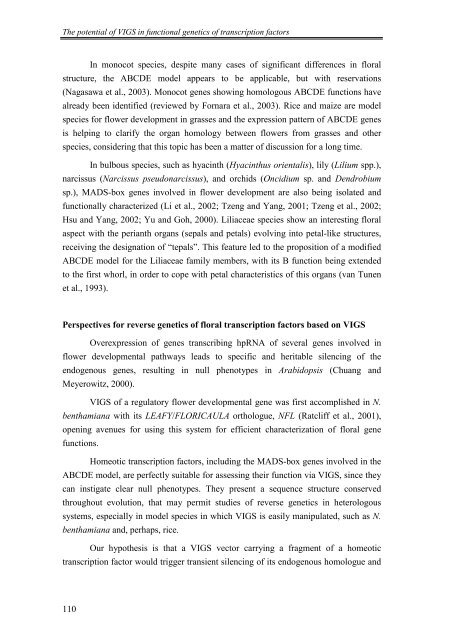Flower development of Lilium longiflorum - The Lilium information ...
Flower development of Lilium longiflorum - The Lilium information ...
Flower development of Lilium longiflorum - The Lilium information ...
Create successful ePaper yourself
Turn your PDF publications into a flip-book with our unique Google optimized e-Paper software.
<strong>The</strong> potential <strong>of</strong> VIGS in functional genetics <strong>of</strong> transcription factors<br />
In monocot species, despite many cases <strong>of</strong> significant differences in floral<br />
structure, the ABCDE model appears to be applicable, but with reservations<br />
(Nagasawa et al., 2003). Monocot genes showing homologous ABCDE functions have<br />
already been identified (reviewed by Fornara et al., 2003). Rice and maize are model<br />
species for flower <strong>development</strong> in grasses and the expression pattern <strong>of</strong> ABCDE genes<br />
is helping to clarify the organ homology between flowers from grasses and other<br />
species, considering that this topic has been a matter <strong>of</strong> discussion for a long time.<br />
In bulbous species, such as hyacinth (Hyacinthus orientalis), lily (<strong>Lilium</strong> spp.),<br />
narcissus (Narcissus pseudonarcissus), and orchids (Oncidium sp. and Dendrobium<br />
sp.), MADS-box genes involved in flower <strong>development</strong> are also being isolated and<br />
functionally characterized (Li et al., 2002; Tzeng and Yang, 2001; Tzeng et al., 2002;<br />
Hsu and Yang, 2002; Yu and Goh, 2000). Liliaceae species show an interesting floral<br />
aspect with the perianth organs (sepals and petals) evolving into petal-like structures,<br />
receiving the designation <strong>of</strong> “tepals”. This feature led to the proposition <strong>of</strong> a modified<br />
ABCDE model for the Liliaceae family members, with its B function being extended<br />
to the first whorl, in order to cope with petal characteristics <strong>of</strong> this organs (van Tunen<br />
et al., 1993).<br />
Perspectives for reverse genetics <strong>of</strong> floral transcription factors based on VIGS<br />
Overexpression <strong>of</strong> genes transcribing hpRNA <strong>of</strong> several genes involved in<br />
flower <strong>development</strong>al pathways leads to specific and heritable silencing <strong>of</strong> the<br />
endogenous genes, resulting in null phenotypes in Arabidopsis (Chuang and<br />
Meyerowitz, 2000).<br />
VIGS <strong>of</strong> a regulatory flower <strong>development</strong>al gene was first accomplished in N.<br />
benthamiana with its LEAFY/FLORICAULA orthologue, NFL (Ratcliff et al., 2001),<br />
opening avenues for using this system for efficient characterization <strong>of</strong> floral gene<br />
functions.<br />
Homeotic transcription factors, including the MADS-box genes involved in the<br />
ABCDE model, are perfectly suitable for assessing their function via VIGS, since they<br />
can instigate clear null phenotypes. <strong>The</strong>y present a sequence structure conserved<br />
throughout evolution, that may permit studies <strong>of</strong> reverse genetics in heterologous<br />
systems, especially in model species in which VIGS is easily manipulated, such as N.<br />
benthamiana and, perhaps, rice.<br />
Our hypothesis is that a VIGS vector carrying a fragment <strong>of</strong> a homeotic<br />
transcription factor would trigger transient silencing <strong>of</strong> its endogenous homologue and<br />
110














